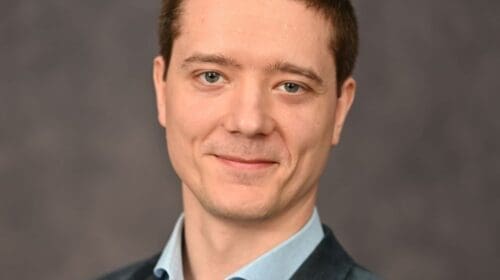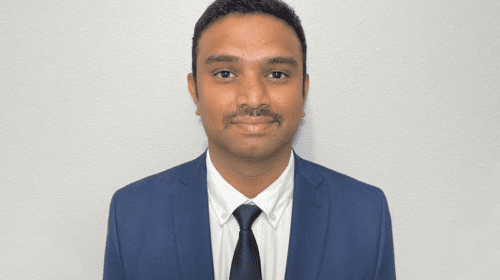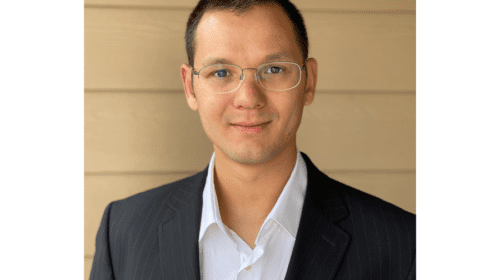
Alan Alexeyev: Please introduce yourself and your area of expertise.
Sofiane Djezzar: I am an enthusiastic geoscientist at the University of North Dakota (UND) Energy and Environmental Research Center (EERC), where I am in charge of developing geomechanical, geophysical and geological models of the subsurface. My research focuses on carbon sequestration, underground gas, hydrogen storage, wellbore and reservoir integrity. My principal areas of interest and expertise include CO2 and gas storage, 1D/3D geomechanics modeling, salt cavern, enhanced oil recovery, borehole imagery analysis, 3D/4D seismic data interpretation, characterization and modeling of naturally fractured reservoirs using core, borehole images, and seismic attributes; high-pressure mercury injection (HPMI) data analysis, core description, and thin-section analyses; basin and reservoir modeling, and petroleum system evaluation.
AA: What are your qualifications and diplomas and which topics did you work on?
SD: I hold a Ph.D. degree in Petroleum Engineering from the University of North Dakota (UND). My dissertation is titled Fracture detection and prediction in unconventional reservoirs for finding the sweet spot. In my dissertation, I proposed a specific and innovative workflow to analyze and characterize the natural fractures in the Cambro-Ordovician reservoir by using an analog that appears on the southern edge of the Mouydir basin, Algeria, to bring new insight and guide future exploration in this basin. This workflow integrates multiple data that help to build a deterministic fracture model. This model highlights the major and minor fractures that aid in understanding the basin’s geological evolution as well as the impact of the basement fractures on the basin structure and on the sedimentary cover. The 3D fracture model is used to understand fracture distribution, fracture connectivity, and fracture kinematics. The outcomes could be used to predict fractures’ extension and occurrence in the subsurface and could be used to explain the negative results of the drilled wells.
Also, I hold a Magister degree in Structural Geology from USTHB. My thesis was related to studying The impact of natural fractures on the productivity of lower Devonian reservoirs in the Reggane basin, Western Sahara, Algeria. During this study, I performed stratigraphic and structural studies of the Lower Devonian reservoirs. The different sedimentary facies show that the Lower Devonian deposits were emplaced in a system including fluvial, coastal and detrital platform environments, dominated by the dynamic action of storms. Surface and subsurface observations (geological and seismic) show that the Hercynian phase is the main phase that structured the Reggane basin.
In addition, I hold an Engineer degree in Structural Geology from Houari Boumediene Sciences and Technology University (USTHB) Algiers, Algeria. My engineering thesis is titled Structural and stratigraphy studies on Paleozoic series in Beni-Affeur’s area, Northern Algeria. The outcomes of my thesis were the generation of geological maps at 1:25000 and 1:50000 scales, stratigraphy, sedimentology and petrography analysis of the basement and sedimentary rock samples, fracture and fault mapping, fracture kinematics, and fracture distribution, listing the different tectonic events that affect the basement and the sedimentary series, and their chronology, and highlighting the impact of the basement faults on the sedimentary cover.
I am an author and coauthor of numerous professional publications.
AA: Tell us about your work experience in the oil and gas industry and academia.
SD: I have almost four years of experience at the EERC where I have contributed to diverse projects related to geomechanics 1D/3D, CO2 and gas sequestration, CO2/Enhanced oil recovery, seismic interpretation, and geological modeling. I deliver reservoir characterization support to modeling and simulation groups, focusing on geomechanics, rock typing, petrography, capillary pressure analysis, and geophysics. I provide technical support and guidelines to the team. I advise asset teams on new/existing technologies and propose technical solutions, oversee the application of those technologies. I work with multidisciplinary teams and across geosciences to provide data and solutions that address our client’s needs. I perform and supervise geomechanical, geophysical and geological works on the following basins: Williston and Powder River Basins. I develop geomechanical models and workflows to estimate rock mechanic properties at well and basin scale ensuring integration of wireline and core analysis. I characterize and predict fracture and fault reactivation and risk assessment for CO2 leakage by analyzing natural fractures in the confining and injection zones using high-pressure mercury injection data, borehole images, core data and 3D seismic volumes. I provide the characterization of tectonic and sedimentary features using borehole images in conjunction with core data. I supervised undergraduate and graduate students working as research assistants at the EERC.
Also, I worked as an expert structural geologist for the Algerian oil company, Sonatrach, for almost 20 years. I worked over various reservoirs (carbonate and siliciclastic). I have strong experience in field exploration planning, structural geology, basin modeling, geochemistry, rock typing, and characterization of fractured reservoirs. I have carried out many structural and geomechanical interpretations (on a well-by-well basis, and on a field and basin basis). I have strong experience processing and interpreting borehole images recorded on water or oil-based muds. High experience in log/core data QAQC, core analysis, relative permeability, capillary pressure curves, and saturation height functions analysis. As a team leader structural geologist, I provide 2D/3D seismic analysis and faults/ fracture interpretation, discrete fracture network generation for conventional and unconventional reservoirs, and 1D/3D geomechanics models. I advised several master’s students from the University of Boumerdes and USTHB.
In addition, during the preparation for my Ph.D. dissertation, I taught well logging and advance well log interpretation courses for two years in the petroleum engineering department at UND, handling more than 30 undergraduate and graduate students. I was in charge of teaching courses and preparing homework, projects and exams in multimineral evaluation using conventional well logs and advanced well logs, such as NMR and borehole images.
AA: What advice would you give to the young professionals in the oil and gas industry?
SD: Young professionals should work hard to develop their skill sets in different disciplines. They must be multidisciplinary focusing on research in geology, geophysics, petrophysics, geomechanics, reservoir engineering, production and so on. Also, programming skills and other topics related to machine learning and artificial intelligence should be well handled. They should attend conferences and seminars to [keep] their knowledge up to date, and increase connections and networking through specific social media to share and learn from their peers.
AA: How do you see the oil and gas industry in the short, mid, and long term in the U.S. and around the world?
SD: I believe that oil and gas will stay the main source of energy in the short and midterm around the world. The U.S. has worked hard to reduce its dependence on foreign oil and, at the same time, is working to be the leader in the growth of different energy resources such as hydrogen, geothermal and so on. Everyone believes that renewable energy is the future. Huge investments should be done now to secure the energy of the future. Energy is a matter of sovereignty, and we must manage to secure the energy for future generations. Developed and emerging countries are making huge investments in research to find alternative energy for oil and gas and the country that first controls this new energy, will lead the world.
Alan is a graduate from the University of North Dakota with a Master's degree in Petroleum Engineering. He previously earned his BA in Mathematics from the University of Houston and a BS in Petroleum Engineering from the University of Wyoming. Alan is an active SPE member and has presented at petroleum conferences and exhibitions.
Oil and gas operations are commonly found in remote locations far from company headquarters. Now, it's possible to monitor pump operations, collate and analyze seismic data, and track employees around the world from almost anywhere. Whether employees are in the office or in the field, the internet and related applications enable a greater multidirectional flow of information – and control – than ever before.












